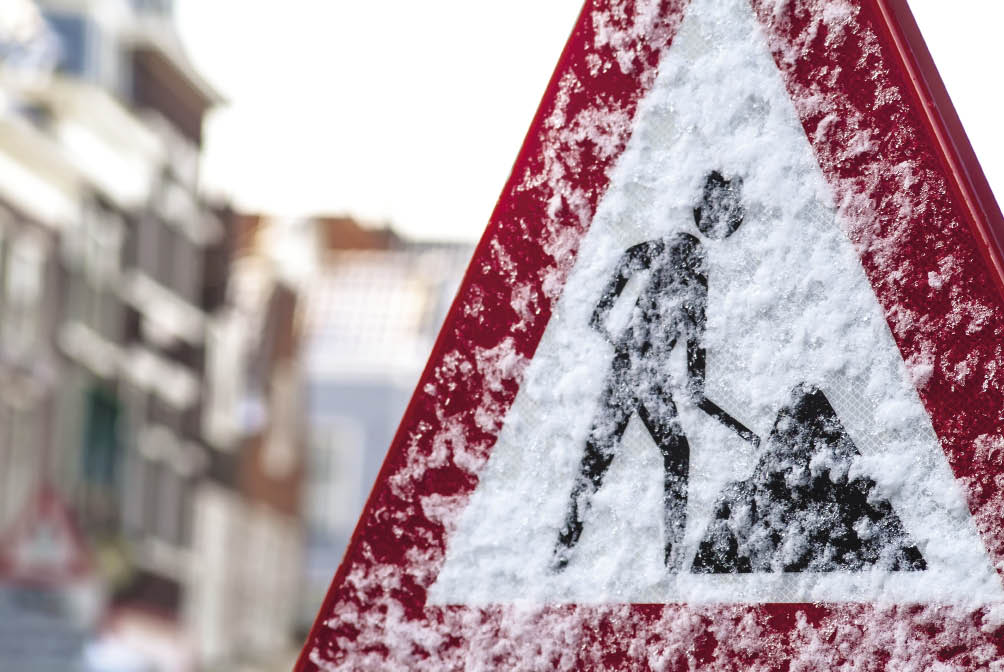
Winter-proofing your work zone
By Nina Sharpe
Seasonal work poses unique challenges that can put employees at risk

Proper preparation prevents poor winter performance. (DutchScenery/Getty Images)
Winter construction work poses unique challenges that, without the proper knowledge, can put your workers at risk.
To make construction sites safer this winter, here’s a list of safety tips that will significantly lower risks and threats.
Preseason planning and hazard assessment
Before the winter season arrives, a preseason meeting should be held, involving management, clients, contractors and workers. The meeting should address topics related to the schedule of activities, requirement and availability of material and equipment, site mobilization and hazard assessment.
Hazard assessment is not a one-time activity. The site, weather and equipment should be surveyed every day to ensure there are no hazards present.
Common hazards include:
• slippery surfaces and reduced traction
• potholes covered in snow
• poor road conditions
• falling snow and ice from the top of roofs of buildings and equipment
• sudden snowstorms
• reduced visibility
• poor lighting
• downed power lines
• big rocks and other large items buried under ice.
Another important step to ensuring worker safety is monitoring the weather and using weather forecasts to create work schedules.
Since weather forecasts more than 10 days in the future are not accurate, it’s best to not depend on preseason forecasts, but rather update work schedules with new weather information every day.
Snow removal, de-icing and sanding are crucial after heavy snowfalls. Walkways and roadways should be prioritized. The construction site should also have enough snow removal tools and equipment.
Building and trailer winterization
Not all buildings are fit to be used by construction workers in the winter, so it’s important to figure out which buildings can be occupied and which will be sealed off before work begins.
Even buildings in excellent condition may require additional steps to prepare them.
A building being used during construction should have:
• snow removal equipment placed on decks, walkways and stairs
• storage locations for de-icer and grit
• “no-slip” material such as salt and sand on stairs and walkways
• handrails on stairs
• adequate lighting
• all doors and windows latching securely
• properly working piping and utility systems (in sub-zero temperatures, heat trace with insulation or an anti-freeze treatment may be required).
Winter PPE selection
Personal protective equipment (PPE) is the last line of defence. The correct PPE can go a long way in mitigating the risk of hypothermia and injuries.
Through the winter season, it is imperative that workers wear clothes in layers. The base layer generally includes thermal innerwear (top and pants, wool socks). Then comes the insulating layer (jackets, windbreakers) and finally the outer layer (face masks, outer wind-block pants).
It’s important to wear clothes in layers as workers can shed layers easily if the temperatures suddenly increase or the sun comes out. This is important, as too much clothing in warm temperatures would lead to excessive sweating. If the temperatures were to dip again, the sweat could increase risk of hypothermia.
There are some key factors that should be taken into consideration when selecting winter PPE for different work roles. These factors include mobility, vision (certain eyewear can block line of sight) and dexterity. Boots, gloves and eyewear should also be chosen carefully depending on the work environment and employee role.
It’s recommended that the PPE should be ordered and stocked up in September to ensure enough units are available.
Emergency preparedness, response, evacuation
Emergency preparedness includes topics such as emergency communications, response times and evacuation
procedures.
It’s important that the necessary drills and procedures are tested and taught to workers during the planning stage.
Here are some things to keep in mind during emergencies:
• Due to bad weather, emergency services and first responders can take significant time to arrive on scene. It’s important that workers are given basic training to administer first aid.
• Every vehicle should have a first-aid kit, torch, batteries, food, blankets, snow removal equipment and radio. In case the vehicle gets stuck, operators should be trained to radio for help and stay inside the vehicle.
• Shelter in place needs to be identified or set up before work begins.
• A site-wide alert system should be installed for notifications. This could be done through a PA system — although remote workers and vehicle operators should also be notified of severe weather or of any other emergencies through a radio.
• Evacuation plans should be drafted during preseason planning and a secondary contractor should be on call for snow removal and evacuation, especially if there is a chance of weather conditions deteriorating severely.
Vehicle, equipment maintenance
Vehicle operation, maintenance and safety procedures change a fair bit in winter. Ensure heavy equipment operators and workers are safe by:
• conducting a thorough check of the machinery (look for snow and ice buildup, cracks, rust, severed or frozen pipes)
• letting the vehicle warm up before beginning work
• ensuring all fluids are at optimal levels
• referring to the manufacturer’s guide to ensure tires are at the right pressure
• checking engine pressure, lights, horns, radio and making sure all emergency equipment is present during warm-up.
Other tips to remember
Finally, winter construction workers can stay safe by:
• avoiding excessive coffee consumption and other caffeinated/energy drinks
• making sure a warm breakroom is always open
• avoiding excessive sweating by taking breaks when necessary
• ensuring work temperatures do not fall below legal range
• being aware of the signs of hypothermia and frostbite and the correct steps to follow if signs are present.
The winter season changes safety procedures and it is important to begin preparing months in advance.
If construction in the winter season is regular for you, it would be worthwhile to invest the time and money into creating a dedicated winter safety program.
Nina Sharpe is a content writer for SkidHeaven.com, writing about heavy equipment and construction safety.